Black History Month revisited and remembered
With a mix of traditional, innovative activities, Mac backed Black in 2022 in more ways than ever before
March 2, 2022
This Black History Month at McCallum, events on campus presented opportunities of all kinds. For some, it was an opportunity for education. For others, it was a celebration of Black excellence and culture. For others still, it was a chance to uplift student voices on issues that matter to them.
Speakers like Dr. Leonard Moore, a UT history professor, and Yvonne Adams, a cultural and diversity specialist, gave presentations on Black history. Student panelists shared their experiences as people of color at McCallum, illuminating underlying issues that may go unnoticed. Junior Regan Sims created a piece of artwork depicting the microaggressions she faces on a daily basis as a person of color, and her art won the Black Girl Magic contest organized by Fine Arts Academy assistant Tonya Moore. The contest, in which Sims won a Black Girl Magic T-shirt and a $25 gift card, was a way to incentivize students to celebrate Black women’s resilience and excellence in the face of adversity.
“[Racism is] still out there,” Moore said. “Which is why Black girl magic is so important, because we have to teach our kids that they’re beautiful no matter what skin tone they are.”
In other cases, education was more hands-on. On Feb. 24, seniors Tracy Atoo and Ashley Nicely demonstrated the process of braiding cornrows and box braids in the main hallway, explaining the history of Black hair to curious passers-by.
Some faculty took the celebration of Black history month into their own hands. Librarian Jain Orr set up a book display in the library celebrating Black resilience, and college and career counselor Camille Nix set up a display of pennants for historically Black colleges and universities.
At the end of Black History Month, we look at the impact of all these events on the community that will hopefully last well into the future.
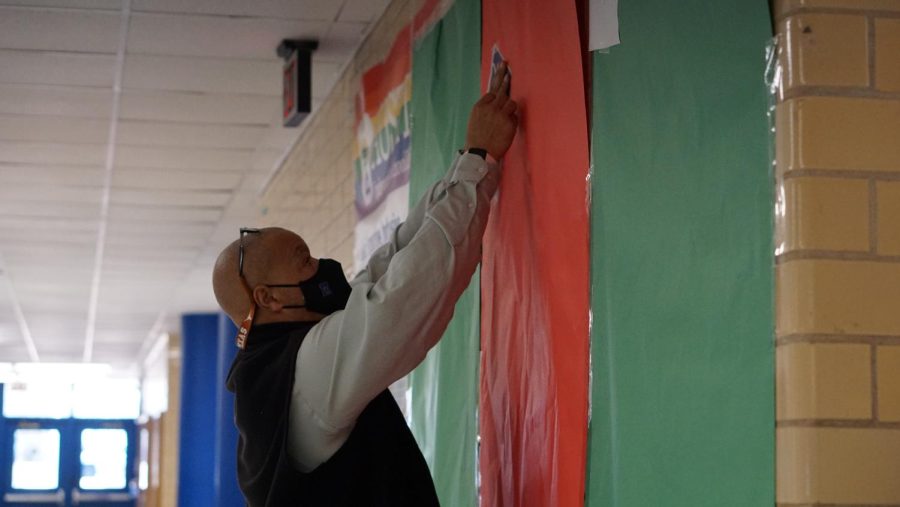
MAC BACKS BLACK IS BACK: Assistant principal Larry Featherstone starts to add content to the Black History Month wall in the main hallway. Featherstone has spearheaded the school’s efforts to make the school’s observance of Black History Month purposeful for many years, and in 2022, he collaborated with student leaders in the Students of Color Alliance and SOCA sponsor Tonya Moore to develop the slate of Black History Month activities. Photo by Dave Winter.
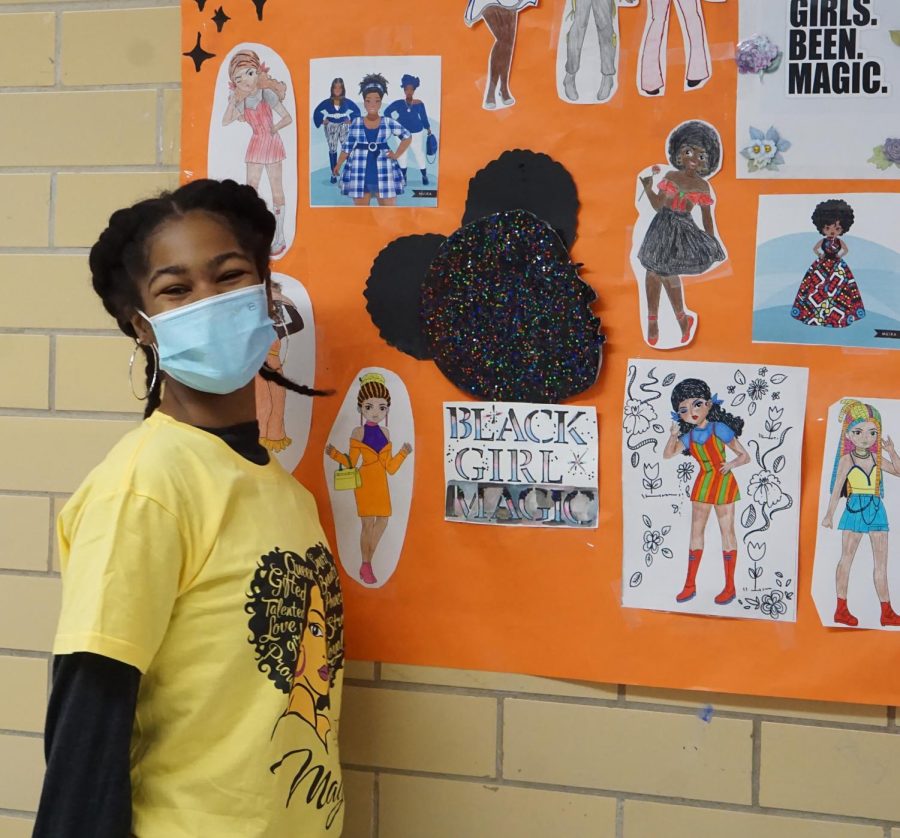
BLACK MAGIC WOMAN: Senior and Students of Color Alliance member Ashley Nicely poses in front of the “Black Girl Magic” poster featuring artwork from students depicting what the movement means to them. Nicely is wearing the T-shirt that was awarded to the winner of the Black Girl Magic art contest received on Feb. 17. “When I hear ‘Black girl magic,’ I think of Black women succeeding and accomplishing their goals,” Nicely said. Tonya Moore, the sponsor of the SOCA club, said that Black women’s ability to overcome adversity is the source of “the magic.” “The magic comes from the fact that people don’t always recognize Black women,” Moore said. Photo by Francie Wilhelm.
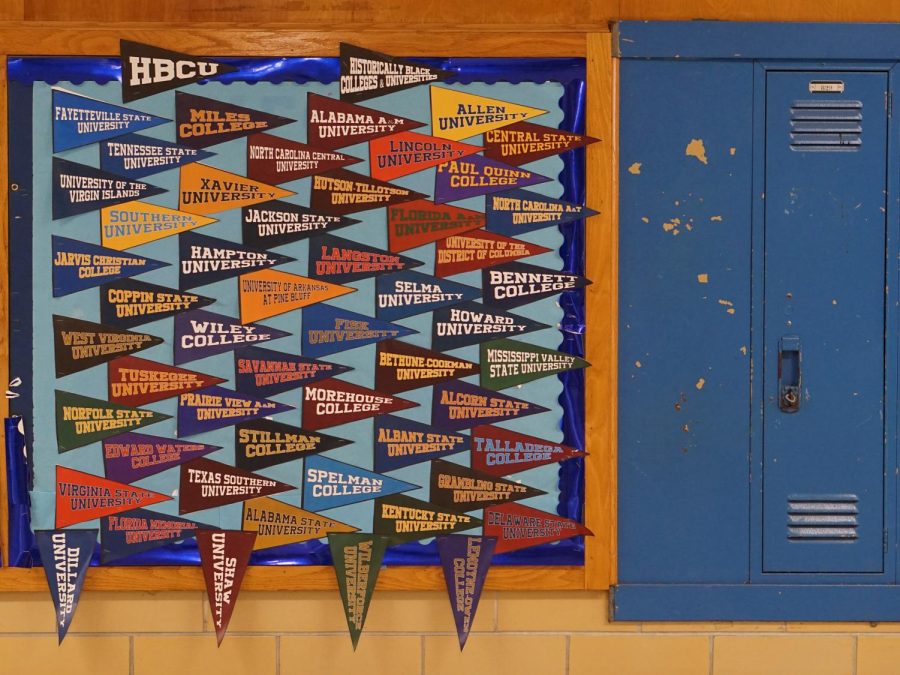
MAC BACKS HISTORICALLY BLACK: As part of the school’s observance of Black History Month, College and Career counselor Camille Nix created a bulletin board display made of miniature pennants of HBCUs. “We want to showcase some of the amazing historically black colleges and universities,” Nix said in an Instagram post on Feb. 2. Photo by Dave Winter.
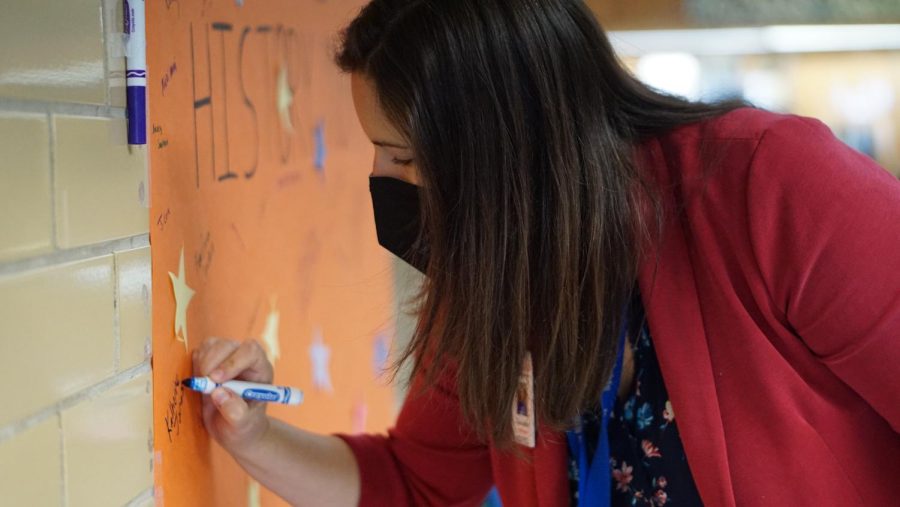
A MATTER OF PRINCIPAL: Students, teachers and even principal Nicole Griffith were encouraged to add names of Black role models from history, current times or their personal lives. Griffith
wrote Mae Jemison’s name on the wall. Ms. Griffith describes Jemison as “cool” and “very awesome,” since she was the first African American woman to go to space despite being told many times she would never be able to. “We are celebrating culture, and that has been very positive” Griffith said of the Mac Back Blacks events. “I’ve really enjoyed the festivities and the educational moments that we’ve had this month.” Photo and caption by Gaby Esquivel.
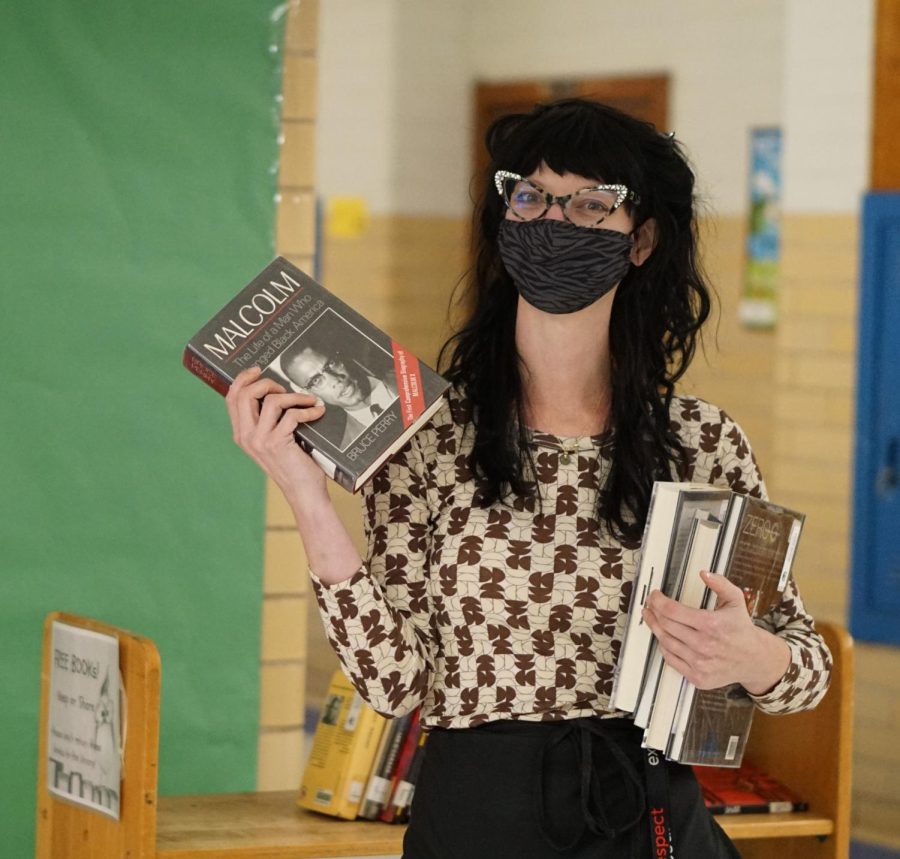
BLACK HISTORY KEEPSAKES: During fourth period on Feb. 7, head librarian Jain Orr stocked the Black History Month display emerging in the main hallway with some Black History books that were free for the taking. “As we were updating our collection and getting rid of books students don’t need anymore, we set aside books for Black History Month,” she said. “The spirit is of celebration.” The display of books was so attractive that students were reluctant at first to disrupt the arrangement by taking the books which were free to whoever wanted them. As the month progressed, however, students did start claiming the books as their own. Photo by Dave Winter.
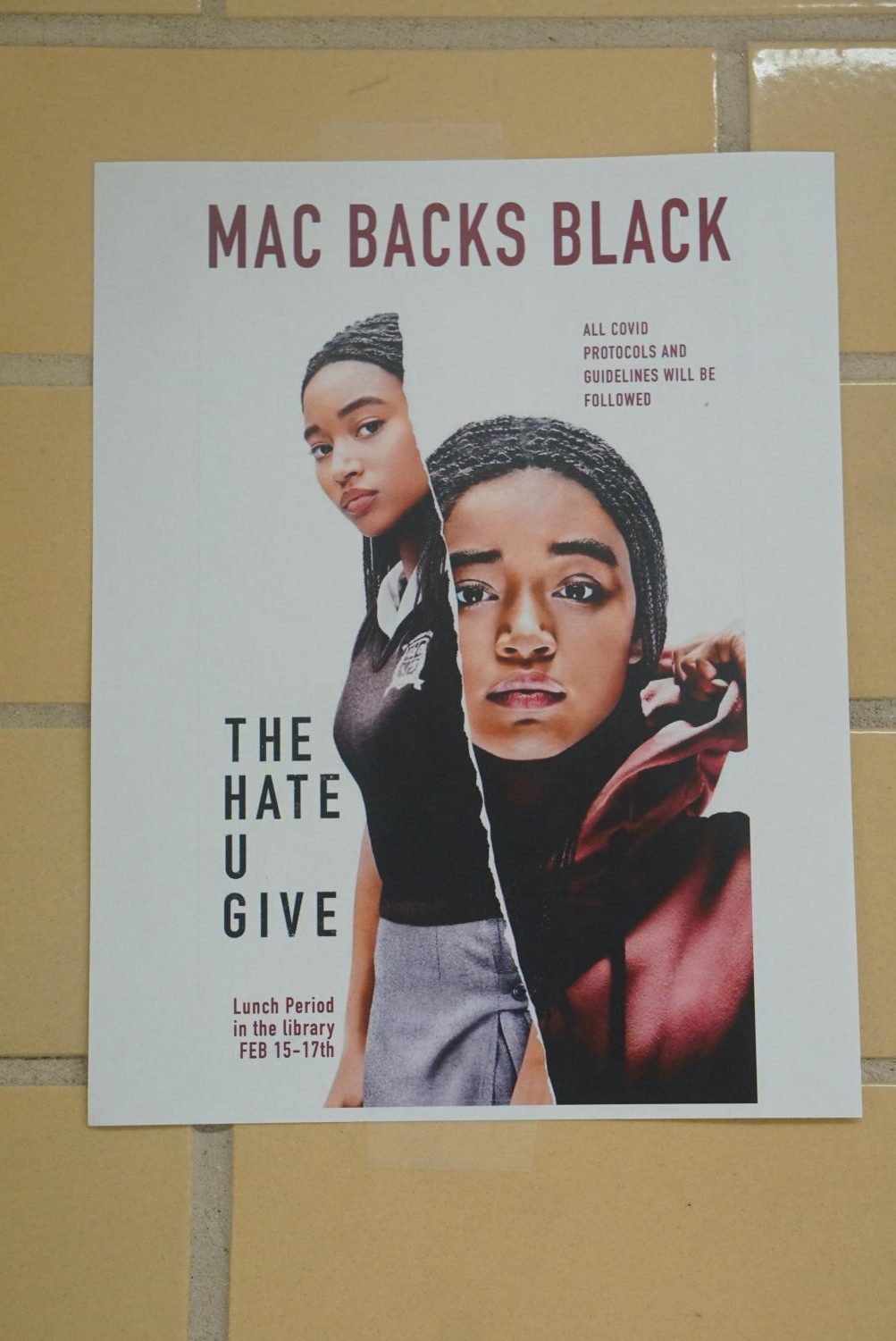
LUNCHTIME MOVIE KNIGHTS: As part of the school’s observation of Black History Month, the Students of Color Alliance sponsored a lunchtime showing of the film, “The Hate U Give,” over several days in the library. Admission was free, and seating was limited. Directed by George Tillman Jr., the film features 16-year old main character Starr Carter who suffers a terrible loss and must navigate the divide between the poor neighborhood where she lives and the fancy suburban prep school she attends. Photos and reporting by Gaby Esquivel.
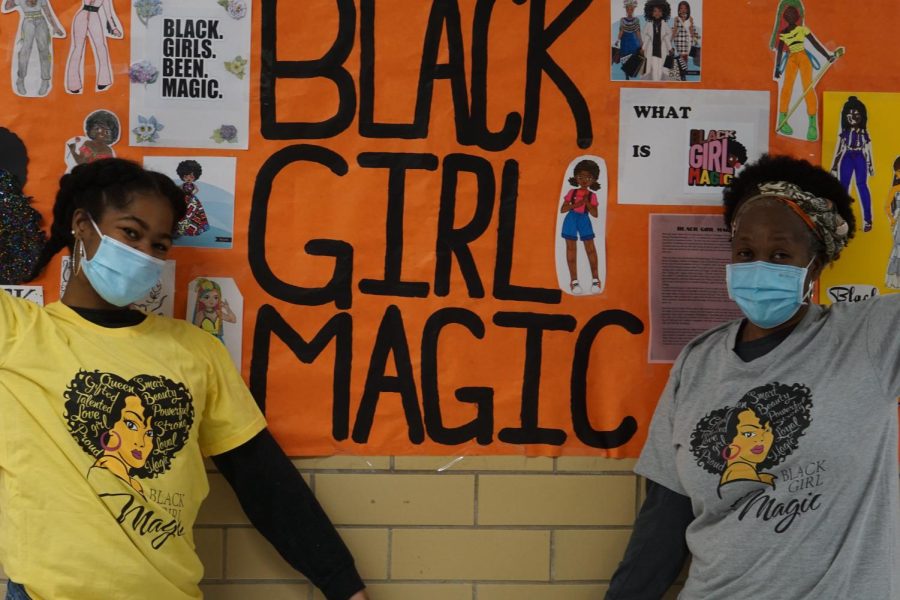
BELIEVING IN MAGIC: Senior Ashley Nicely and Fine Arts Academy clerk Tonya Moore pose in the Black Girl Magic contest T-shirts in front of the Black Girl Magic poster in the main hallway. The poster featured artwork created by students about what the Black Girl Magic movement means to them. On Feb. 17, junior Regan Sims and sophomore Jendayi Innocent were named the winner and the runner up in the contest. “Black girl magic is so important because we have to teach our kids that they’re beautiful no matter what skin tone they are,” Moore said. Photo and caption by Francie Wilhelm.
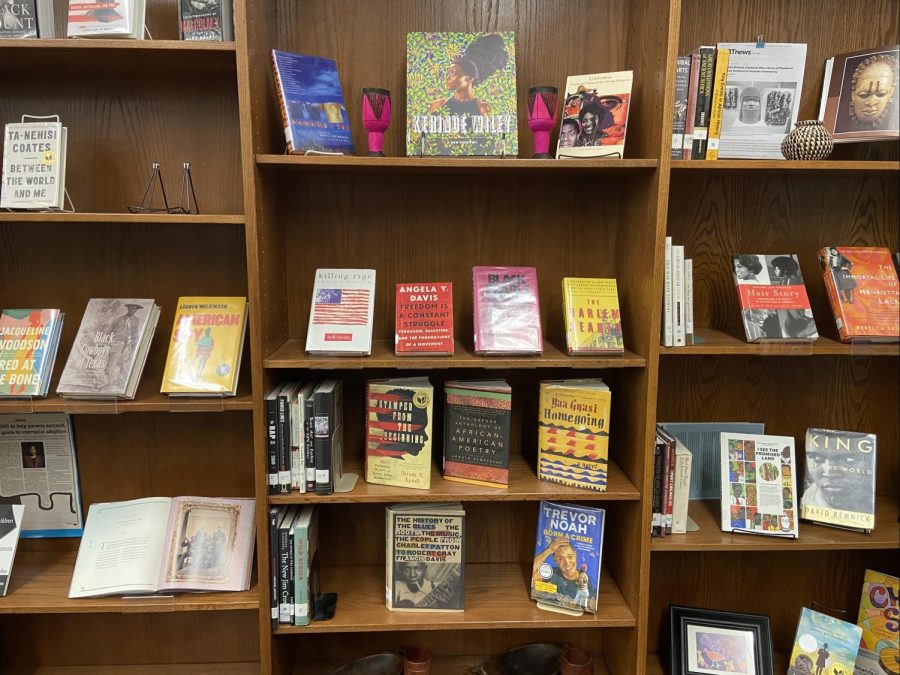
A CELEBRATION OF BLACK RESILLIENCE: When entering the library, students can now see a display of books regarding Black history and celebration. Librarian Jain Orr curated a selection of books while reorganizing the library in January. The shelves also feature artifacts from Orr’s travels in Africa.
“As we were updating our collection and getting rid of books students don’t need anymore, we set aside books for Black History Month,” she said. “The spirit is of celebration.”
These books have also been compiled on Goodreads. A QR code with a link to the list is posted next to the shelves. Orr wanted to make sure that important aspects of Black history were not overlooked and explained that a display is the best way to get students’ attention.
“In general, when a book is facing out, the chances of it getting picked up are, like, a thousand times better,” she said.
Fellow librarian Lauren Alindogan brought their vision to life and organized the shelf. Some of their favorites are Kehinde Wiley: A New Republic by Connie H. Choi and The Immortal Life of Henrietta Lacks by Rebecca Skloot.
“We wanted to highlight the broad spectrum of Black excellence that the curriculum in history isn’t always focused on,” they said. “We wanted more fiction, more contemporary writing and art history.”
Orr and Alindogan hope their efforts help students grow in the knowledge of and respect for Black history.
“Black resilience is really striking,” Alindogan said, “so we made a celebration of things that might get overlooked initially.”
Photo and caption by Evelyn Griffin.
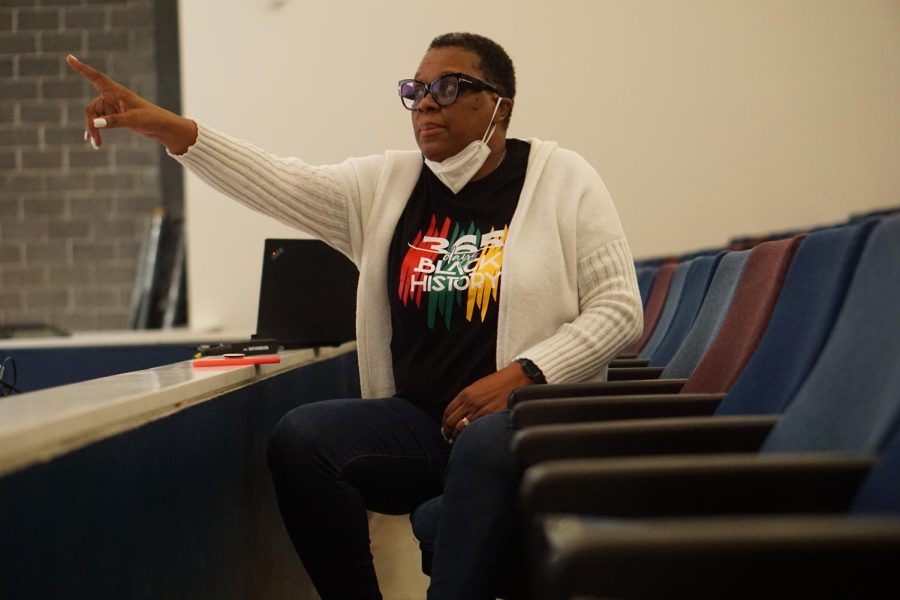
FILLING IN THE MISSING PARTS. On Feb. 17, McCallum enjoyed a guest lecture from Yvonne Adams, the director of equity and inclusion at St. Stephen’s Episcopal School here in Austin, who spoke to students on the subject of Black health and wellness. Adams focused specifically on the experiences of African Americans when it comes to mental health and access to health care, and discussed how systematic oppression and discrimination has affected the Black community. Adams shared that about 13.4% of the U.S. population is Black or African American, and of that percentage 16% reported having a mental illness. “Often times when there’s mental illness in a family, it is taboo to talk about,” Adams said. “In particular, in the Black family, it is hard to talk about, but mental illness doesn’t choose who’s affected by it. But your culture, your race, your gender, your sexual orientation, can oftentimes affect who has access to appropriate treatment.” Caption by Terra Balentine, Noah Braun and Emma Hagood. Photo by Amaya Collier.
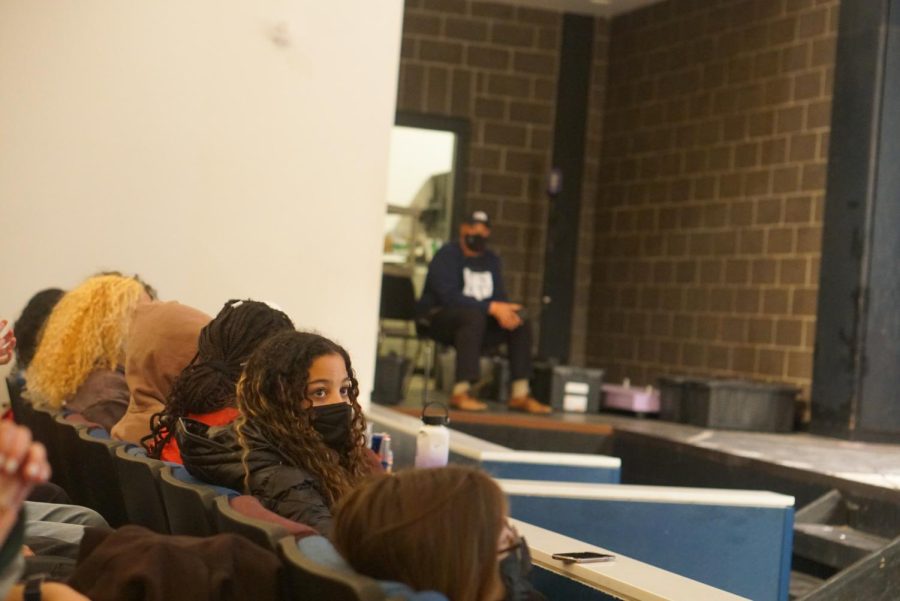
GOOD MORNING, GREAT AFTERNOON: Regan Sims sits with her fifth-period class during the first of three Black History Month presentations made by Yvonne Adams, the director of equity and inclusion at St. Stephen’s Episcopal School here in Austin. While she had a front-row seat in the Mac for the fifth-period lecture, she would take a more prominent location during the eighth-period presentation when she went on stage after winning the Black Girl Magic contest. Photo by Noah Braun.
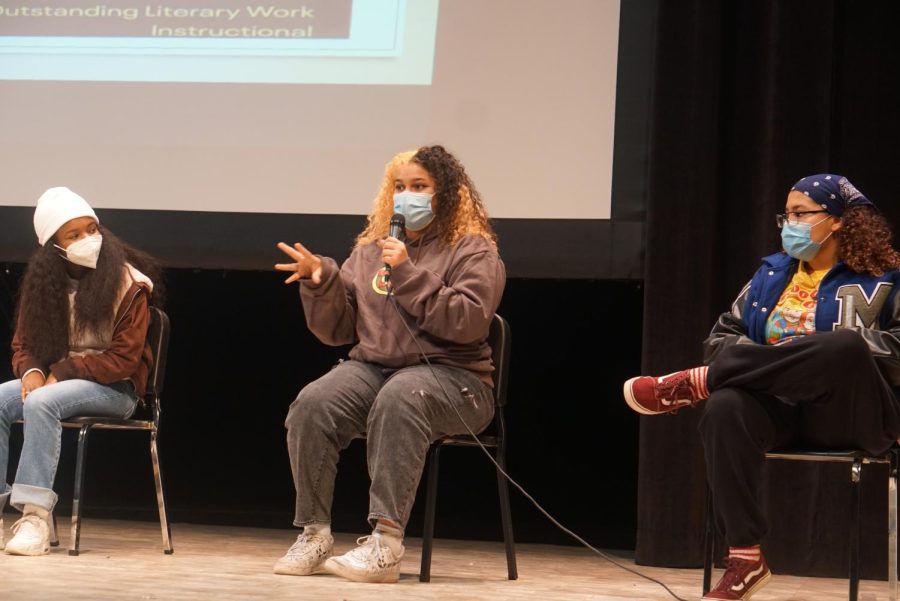
EXPOSING INJUSTICE: Junior Genesis Ritcherson speaks at a Black History Month panel on Feb. 23. Ritcherson shared her experiences going through life as both a biracial person and a member of the LGBTQ+ community. She described what it’s like to constantly have people trying to put her in boxes. “It makes you feel less connected to your ethnicity,” Ritcherson said, “It really separates you from the rest of your peers.” Ritcherson was glad for the opportunity to spread awareness. “Just because you don’t see the injustice happening,” she said, “doesn’t mean it’s not still happening.” Caption by Cassidy Levin. Photo by Kate Boyle.
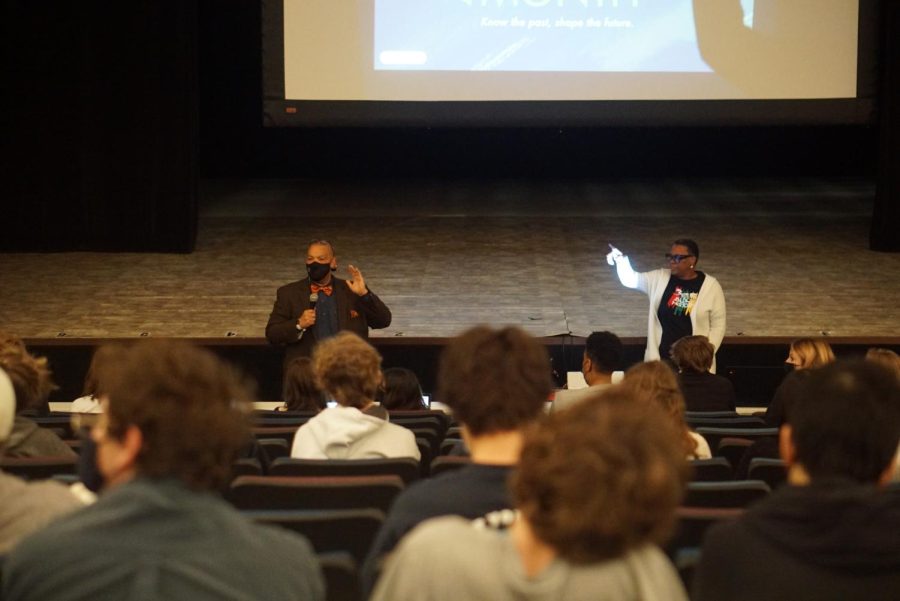
THREE IS THE MAGIC NUMBER: As part of McCallum’s observation of Black History Month, assistant principal Larry Featherstone arranged for three presentations in the MAC on Feb. 17 by Yvonne Adams, the director of equity and inclusion at St. Stephen’s Episcopal School.
Adams urged students to move beyond mainstream Black history figures and learn more about historical figures in all aspects of life, among them medicine, mathematics and science. She also encouraged her audience to make an appreciation of Black history and culture an enterprise that begins on Jan. 1 and ends on Dec. 31.
She stressed that the theme of Black History Month 2022 is Black mental health and wellness. She said that while everyone goes through mental health issues, Black people and people of color find it harder to find resources and be vocal about their issues.
To illustrate that fact, she presented portions of Li’l Wayne’s interview with Emmanuel Acho on the series, “Uncomfortable Conversations,” in which Li’l Wayne discusses the childhood mental health issues he endured, the suicide attempt he survived, and how hard it was for him to seek help.
“To those of you who identify as Black or African-American, get help if you need it. I don’t care what your mother says,” Adams said. “To those of you who do not identify as Black of African-American, get help if you need it.”
Adams said one in five Americans suffer from some mental-health condition. She added that 16 percent of the Black population, roughly 7 million people, have had some mental-health struggle.
The session began with a viewing of poet Amanda Gorman’s performance of the poem, “The Hill We Climb, If Only We Dare It,” at President Biden’s inauguration on Jan. 20, 2021. One of the memorable lines from the poem, “We’ve learned that quiet isn’t always peace,” seemed an appropriate introduction for Adams’s address, which put forth the notion that speaking up about representation, inequity and mental-health issues is an essential step toward making things better.
Adams pointed out that Gorman was the youngest poet ever to deliver an inaugural address. She was 22 when she recited “The Hill We Climb, If Only We Dare It” at Biden’s inauguration.
Photo by Noah Braun.
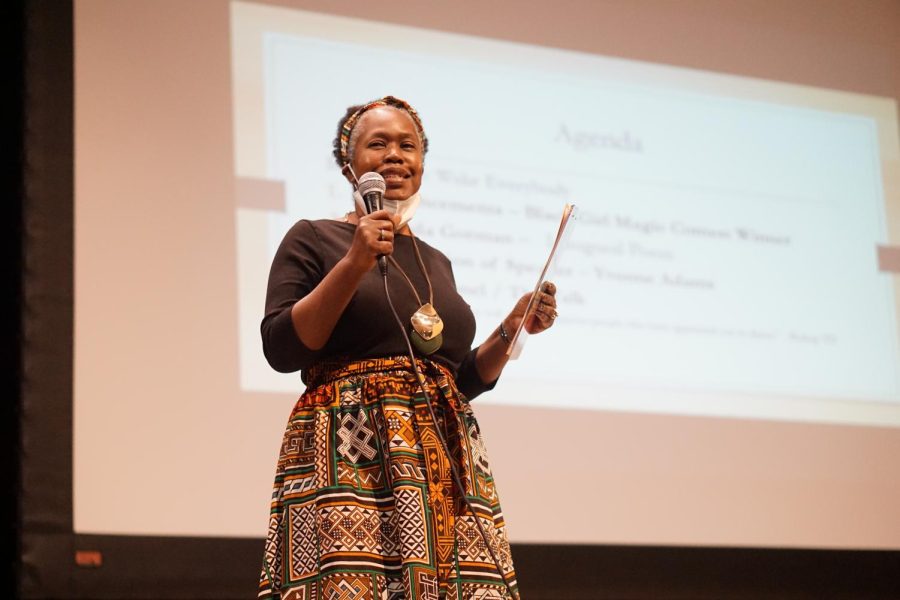
SHARING AND CELEBRATING: Fine Arts Academy Assistant Tonya Moore announces the winner of the Black Girl Magic contest during the eight-period Black History Month assembly in the MAC on Feb. 17. The purpose of the contest was to empower Black girls at McCallum to carry themselves with pride and embrace their “magic.” Moore was eager to bring the Black Girl Magic contest to McCallum for the first time this year to celebrate, support and amplify the voices of the Black girls on campus who she feels are often overlooked. The contest, which was won by Regan Sims, required participants to create a work that showcased what they believed Black Girl Magic stood for.
“It gave me an opportunity to meet a lot of young ladies on campus that I didn’t even know,” Moore said. “[I was] able to show them that there is another Black girl on campus, Black woman, adult that they can get to know and share ideas with and have a safe place where they can come if they feel like they need to talk to someone, someone who looks like them.”
On the day of the contest, Moore dressed in traditional African clothing including a matching headband that she said symbolized Black Girl Magic through emphasizing the importance and beauty of textured hair. According to Moore, McCallum’s 2022 Black History Month celebration was the best she had seen in her four years working at Mac.
“Black History Month means to me that it’s a time to celebrate what African American people have done, but also the fact that it is just American history, period,” Moore said. “I feel like it should be celebrated always.”
Caption by Ingrid Smith. Photo by Amaya Collier.
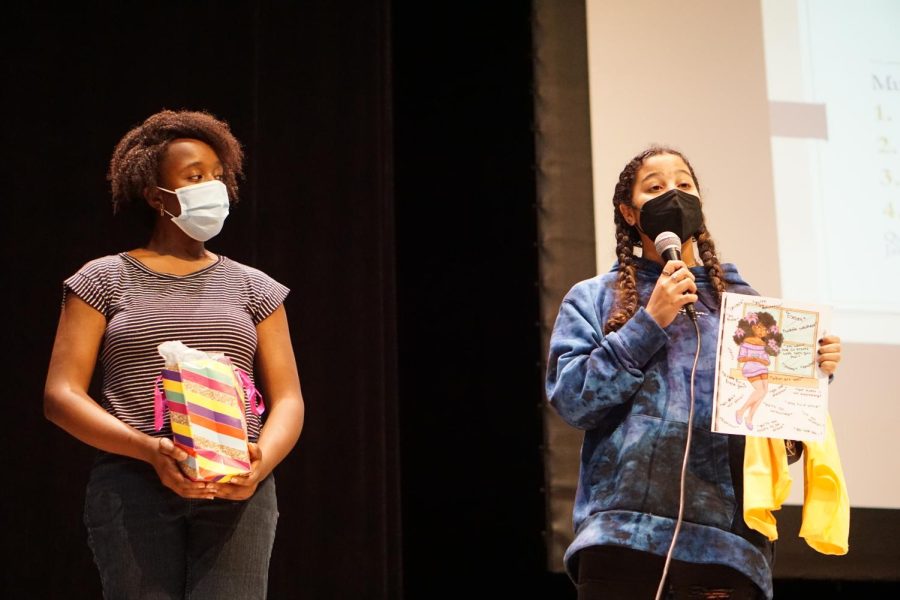
BENEATH THE SURFACE: Sophomore Jendayi Innocent and junior Regan Sims answer audience questions onstage in the MAC after being announced as the runner-up and winner of the Black Girl Magic art contest on Feb. 17. As a classical guitar major, Sims was stepping out of her comfort zone submitting a piece of visual artwork. “I actually wasn’t planning on entering the contest, but Ms. Moore offered me a couple of coloring pages to participate,” Sims said. “I started getting serious about it when I had the idea of writing microaggressions in the background.” These microaggressions spurred conversation over the surprise that Sims faced when she told those around her about things that were said to her. “Anytime I told my friends what people have said to me they’ve been shocked that adults still say this to people, including children,” she said. “My main objective was to shine light on the racism and comments that people of color grow up with and to make everyone aware of their words.” Sims didn’t win because of her coloring skills, but rather the “intention and meaning behind the words I wrote.” She said that people interested in this contest should look past the surface of the artwork: “It’s the meaning behind the art that is powerful.” Caption by Helen Martin. Photo by Amaya Collier.
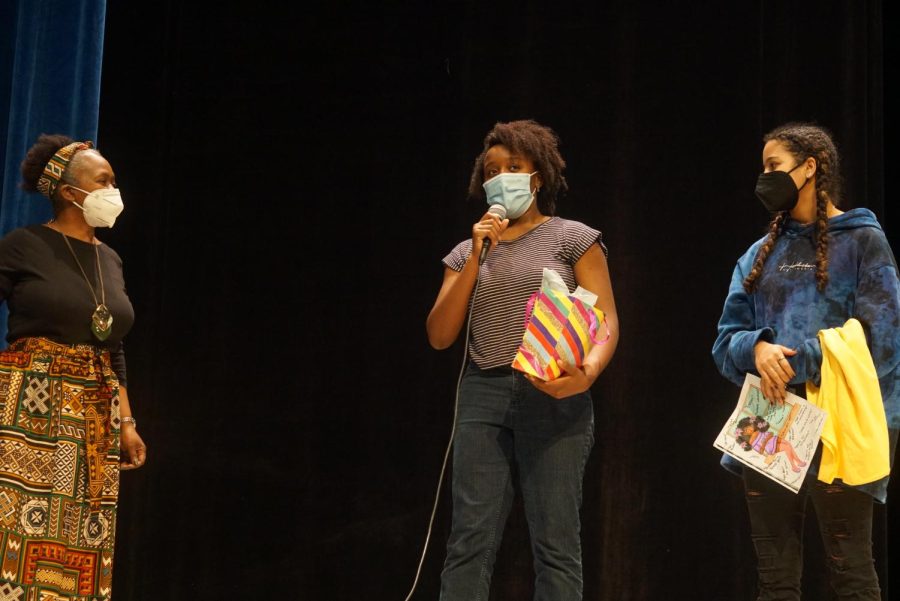
BLACK GIRL MAGIC contest winner Regan Sims (right) and runner-up Jendayi Innocent (left) accept their awards and share their experiences as women of color. The winners accepted their awards from Student of Color Alliance sponsor Tonya Moore in the MAC on Feb. 17 amid a presentation from Yvonne Adams, a cultural and diversity specialist at St. Stephen’s Academy.
The contest was organized as part of the Black History Month event series at McCallum with the aim of uplifting Black women through student artwork. Sims, a junior, won a “Black Girl Magic” T-shirt along with a $25 gift card, and Innocent, a sophomore, won a Black Girl Magic coffee mug. Sim’s winning submission was an art piece depicting a young Black woman with an ambush of micro-aggressions cluttering the background.
“The Black Girl Magic contest, for me, was a way to show others how there is still unconscious racism through microaggressions. I used my submission as a way to share offensive ‘compliments’ that have been said to me or people I know and to share the experiences that I’ve had as a person of color,” Sims said. “I wanted to use my art to put into perspective the words that are said in society and in our school on a daily basis. I wanted other people to know they weren’t alone and to express, not just to non-people of color, but to everyone, to be aware of what they say and try to be conscious of how ‘jokes’ can be perceived.”
Innocent also viewed the contest as an opportunity to embrace her identity. She is especially thankful for contest organizer Tonya Moore, who is leader of the Students of Color Alliance, of which Innocent is a member.
“I feel more free, like I can be myself,” Innocent said. “Ms. Moore has really helped me with not caring about what others think about my skin and my hair, everything about me. I felt more comfortable to wear my traditional clothes to school some days. I haven’t felt this good in a while, like, this contest really did a really good number on me. And knowing that there are people out there who also need a voice and that I helped them, really makes me feel like awesome.”
Caption by Amaya Collier. Photo by Helen Martin.
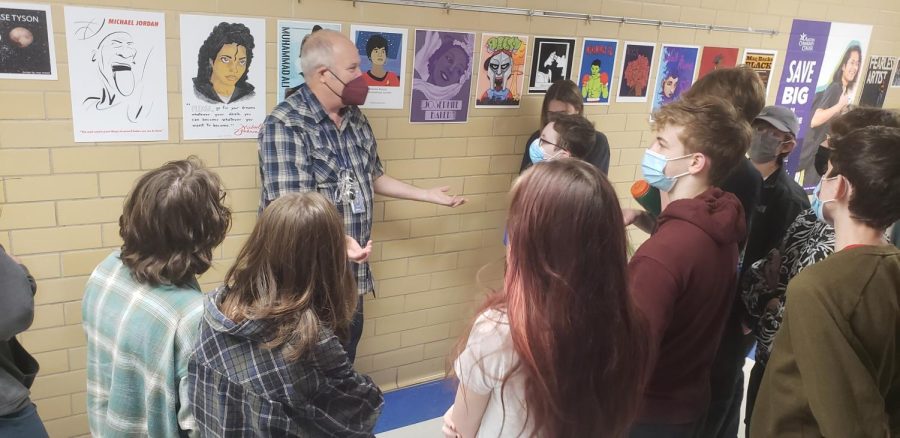
AN ANIMATED DISCUSSION: Animation teacher Tim Carroll brought his class into the hallway on Feb. 17 to discuss the Black History Month posters that he had his students create as part of the schoolwide Mac Backs Black observance of Black History Month. Photo by Dave Winter.
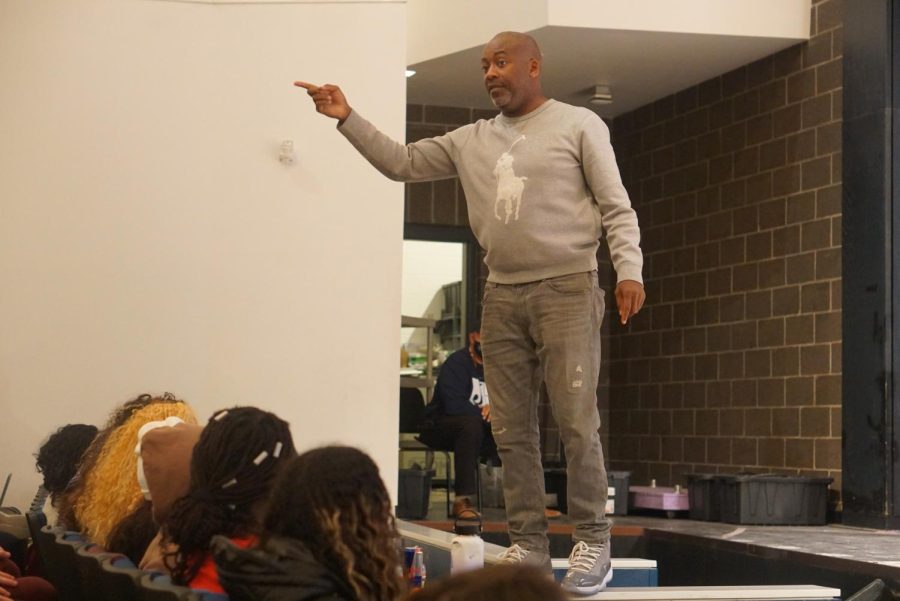
MOORE TO THE STORY: Dr. Leonard Moore, a UT professor and author, came to McCallum to give presentations on Feb. 23. His presentation detailed Black history from the Civil War to current day with a goal to invalidate harmful Black stereotypes. Moore used an analogy to the popular board game Monopoly to explain the challenge faced by Black Americans to move up the income ladder. He invited several white students to the stage, they played according to normal Monopoly rules, while he couldn’t buy any property, and had nothing to pass down to his children. “I went up there thinking I was actually going to play a game of Monopoly and I was excited but when I got up there I realized that wasn’t what he intended on doing,” junior Addy Raleigh said. “It was very interesting and eye-opening how Dr. Moore related not inheriting any land or money and keep having to work, or play monopoly, without actually earning any sort of reward. Being able to listen to Dr. Moore speak about Black history and share life experiences with us Mac students and explain things we may not understand in more detail was such a privilege and I’m glad I got to add to the experience even if it was just standing on stage for five minutes.” Photo and caption by Kate Boyle.
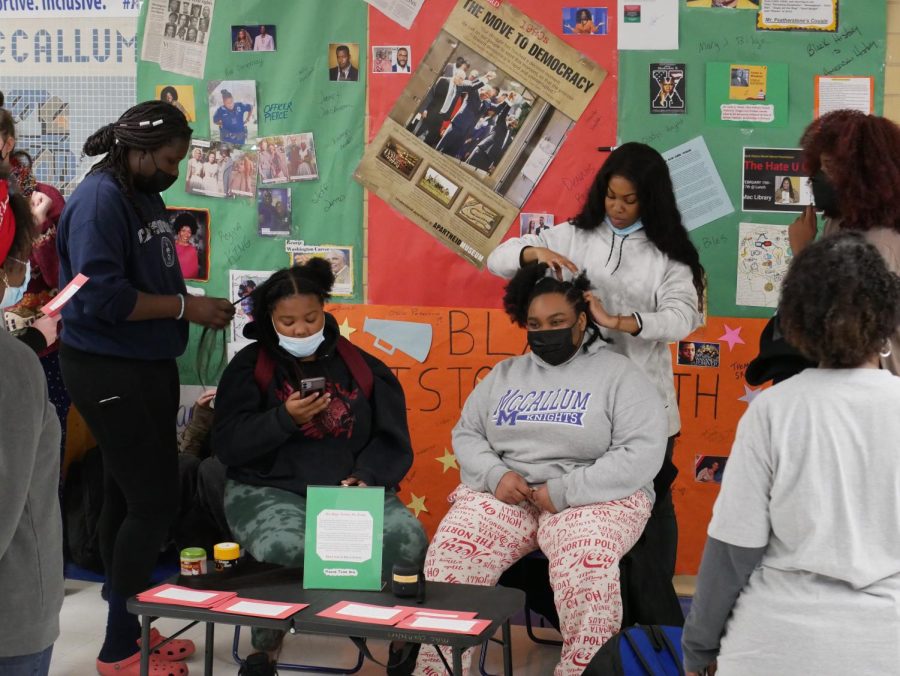
A PAIR WITH HAIR: Seniors Tracy Atoo and Ashley Nicely braid sophomore Nasyah Simpson and junior Karma Lewis’s hair in the main hallway on Feb. 24, Nicely demonstrating cornrows and Atoo opting for box braids. Educating others about Black hairstyles, Atoo reflects, was her favorite part of the demonstration. “At first I was nervous people would look at us in a strange way, but after we started playing music I got more relaxed and had fun doing it,” Atoo said. “It was great seeing all the people interested in learning about Black hair.” Caption by Madelynn Niles. Photo by Dave Winter.
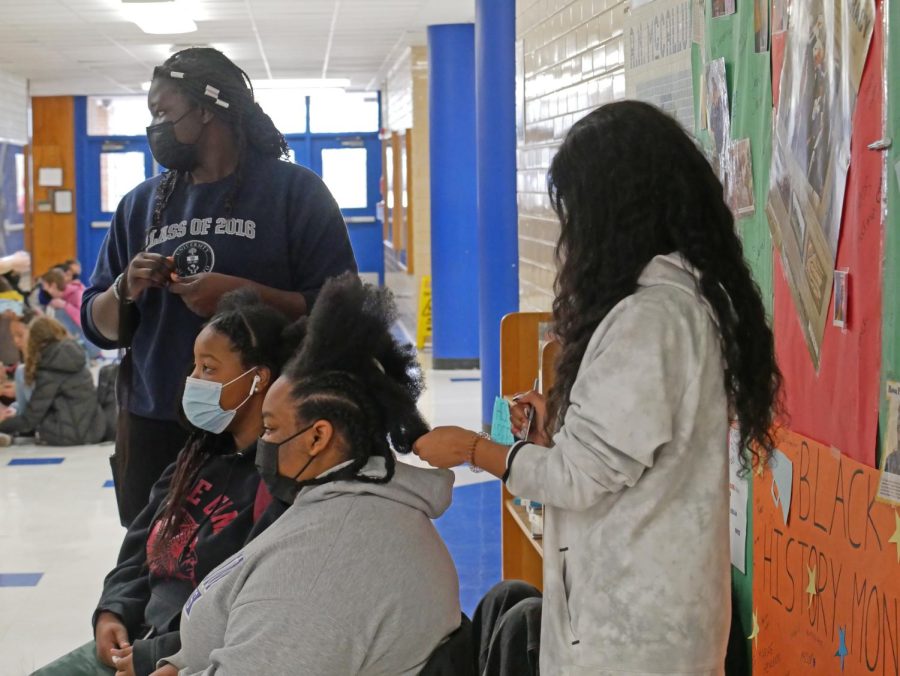
BLACK HAIR IS BLACK HISTORY: During lunch today in the main hallway, seniors Tracy Atoo and Ashley Nicely conducted a demonstration to celebrate and to share the Black history of hairstyles. The demonstration was part of the Mac Backs Black series of Black History Month activities coordinated by the Students of Color Alliance.
Atoo braided sophomore Nasyah Simpson’s hair into box braids and Nicely braided junior Karma Lewis hair into corn braids. According to literature that was distributed at today’s event the purpose of the demonstration was to teach how braids “symbolize strength and wisdom while praying tribute to ancestral roots” and how they are a way for Black Americans to express love and respect for their culture.
In the time of slavery, braids were a way to secretly disseminate a map to freedom. They were also a way to indicate tribe membership and as a place to hide seeds that were essential to short- and long-term survival.
While braids no longer serve these original purposes, they are still an essential part of Black culture even if they aren’t entirely easy.
“We might look beautiful,” sophomore Jendayi Innocent said, “but there’s a lot of pain in making any type of braids.”
Reporting by Gaby Esquivel. Photo by Dave Winter.

WASHED UP IN A GOOD WAY: AVID wrapped up Black History Month on Monday by supporting local black-owned business Just Washed. Owners Brian and Brandon Hill graduated from McCallum in 2006 and have been successful entrepreneurs since 2015.Though they’ve experienced some challenges, they said that they have grown their business to being the No. 1 hand car wash in the Austin area. Despite the fact that senior Naya Domingo got her toes wet because she dashed to the car wash from softball practice, she said the experience was amazing. “The owners, Brandon and Brian, built the business up from the ground and now they’re making easily $100,000 a month,” Domingo said. “We got to help them wash an Alfa Romeo which is a super fancy car. When also did some detailing work for our amazing AVID teachers, Coach Houston and Mrs. Galindo. It was super fun and very inspiring to see how they run the business and hear them light up when they talked about it.” Photo by Zulmy Galindo.




Zo'Riyah Clay • Mar 7, 2022 at 12:02 pm
I loved this article!! I loved how everyone supported Black History Month and how everyone came together to celebrate!
Larry Featherstone • Mar 2, 2022 at 10:08 am
I love this!!! Super AWESOME! Being intentional about supporting Black owned businesses during Black History Month (hope it will continue 365)! McCallum AVID students and staff are AMAZING!!!
Tonya Moore • Mar 2, 2022 at 8:43 am
This is an awesome entry!! It truly captures the rich culture that MAC has to offer. Hats off to all writers and photographers!